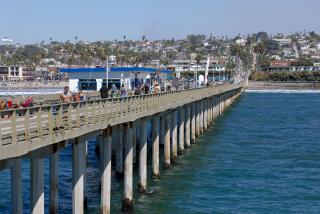Big Dig putting down its shovels
- Share via
BOSTON — When the clock runs out on 2007, Boston will quietly mark the end of one of the most tumultuous eras in the city’s history: The Big Dig, the nation’s most complex and costly highway project, will officially come to an end.
Don’t expect any champagne toasts.
After a history marked by engineering triumphs, tunnel leaks, epic traffic jams, last year’s death of a motorist crushed by falling concrete and a price tag that soared from $2.6 billion to $14.8 billion, there’s little appetite for celebration.
Civil and criminal cases stemming from the July 2006 tunnel ceiling collapse continue, but on Monday the family of Milena Del Valle announced a $6-million settlement with Powers Fasteners, the company that manufactured the epoxy blamed by investigators for the fatal accident. Lawsuits are pending against other Big Dig contractors, and Powers Fasteners still faces a manslaughter indictment.
Officially, Dec. 31 marks the end of the joint venture that teamed contractor Bechtel/Parsons Brinckerhoff with the Massachusetts Turnpike Authority to build the dizzying array of underground highways, bridges, ramps and new tunnel under Boston Harbor -- all while the city remained open for business.
The Central Artery/Third Harbor Tunnel Project -- as the Big Dig is officially known -- has its roots in the construction of the hulking 1950s-era elevated Central Artery that cut a swath through the center of Boston, lopping off the waterfront from downtown and casting a shadow over some of the city’s oldest neighborhoods.
Almost as soon as the ribbon was cut on the elevated highway in 1959, many were already wishing it away.
One was Frederick Salvucci, a city kid for whom the demolition of the old Central Artery became a lifelong quest.
“It was always a beautiful city, but it had this ugly scar through it,” said Salvucci, state transportation secretary during the project’s planning stages.
Rather than building a new elevated highway, Salvucci and others pushed a far more radical solution -- burying it.
Easier said than done.
Those who built the Big Dig would have to undertake the massive highway project in the cramped confines of Boston’s narrow, winding streets, some dating to pre-Colonial days.
Of all the project’s engineering challenges, none was more daunting than the first -- how to build a wider tunnel directly underneath a narrower existing elevated highway while preventing the highway from collapsing.
To solve the problem, engineers created horizontal braces as wide as the new tunnel, then cut away the elevated highway’s original metal struts and gently lowered them onto the braces -- even as cars crawled along overhead, their drivers oblivious to the work below.
The Big Dig’s long history is also littered with wrong turns -- some unavoidable, others self-inflicted.
One of the biggest occurred in 2004, when water started pouring through a wall of the recently opened Interstate 93 tunnel through downtown. Hundreds of smaller drips were also found.
But the project’s darkest day came near the end of construction in 2006, when suspended concrete ceiling panels in a tunnel leading to Logan International Airport collapsed, crushing a car and killing Del Valle, 39, a passenger in the vehicle driven by her husband.
More to Read
Sign up for Essential California
The most important California stories and recommendations in your inbox every morning.
You may occasionally receive promotional content from the Los Angeles Times.













